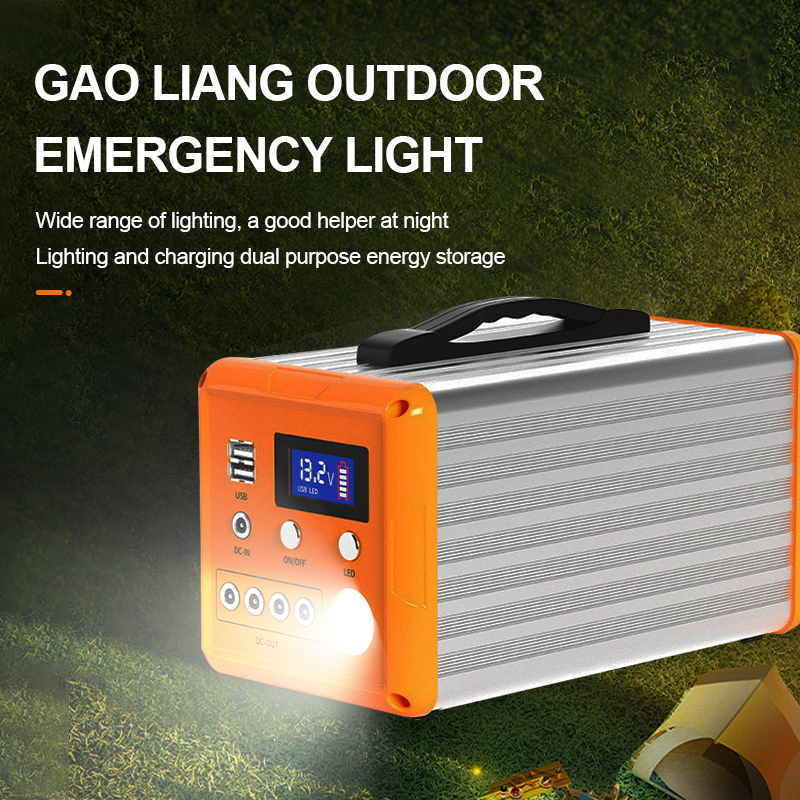1. Advantages of solar generators: Why choose a portable power station?
A solar generator (also known as a portable power station) is a mobile power system that integrates solar charging, large-capacity batteries and multiple output interfaces. It is suitable for camping, self-driving tours, emergency preparedness and other scenarios. Compared with traditional fuel generators, its core advantages include:
✅ Zero noise, zero pollution: no engine noise, no exhaust gas emissions, environmental protection and energy saving.
✅ Solar charging + mains dual mode: use solar panels to charge on sunny days, and use household sockets to replenish power on rainy days.
✅ Multi-function output: supports USB, AC, DC, Type-C and other interfaces, and can power mobile phones, laptops, refrigerators, drones and other devices.
✅ Maintenance-free and long life: lithium batteries can be cycled up to 500-2000 times, and the long-term use cost is low.
2. Five key factors for purchasing a solar power station
(1) Battery capacity (Wh) – determines the endurance
300Wh or less: suitable for low-power devices such as mobile phones, cameras, small fans (short-distance camping for 1-2 days).
500-1000Wh: can support laptops, small car refrigerators, camping lights, etc. (3-5 days of medium and long-distance travel).
1000Wh and above: suitable for RVs and home emergency power supply, can drive high-power appliances such as rice cookers and microwave ovens.
(2) Output power (W) – determines the devices that can be driven
300W and below: suitable for small appliances such as mobile phones, drones, LED lights, etc.
500-1000W: can support laptops, projectors, small refrigerators.
1000W and above: can drive high-power devices such as electric baking trays and electric kettles (pay attention to continuous load capacity).
(3) Solar charging efficiency
Solar panel power: A 100W solar panel can charge about 500Wh in 4-6 hours on a sunny day.
Charging compatibility: Some power stations support multiple solar panels in parallel to speed up charging.
(4) Interface type and quantity
USB-A/USB-C: used for fast charging of mobile phones and tablets.
AC socket (220V): supports laptops and small appliances.
DC 12V/24V: suitable for vehicle-mounted devices and camping lights.
Wireless charging: some high-end models support Qi wireless charging.
(5) Portability and protection
Weight: less than 5kg is suitable for backpackers, and more than 10kg is suitable for vehicle use.
Waterproof and dustproof: IP54 level is splashproof and suitable for outdoor humid environments.
Additional functions: LED lighting, APP smart monitoring, emergency SOS mode, etc.
3. Solar generator vs. fuel generator: How to choose?
Comparison items Solar generator Traditional fuel generator
Noise Silent (0-30dB) Loud (60-80dB)
Fuel Solar/mains Gasoline/diesel
Maintenance Maintenance-free, long life Regular oil change and maintenance are required
Applicable scenarios Camping, family emergency, outdoor office, construction site, long-term off-grid power supply
Environmental protection Zero emission Exhaust pollution
Conclusion:
If you pursue quiet, environmentally friendly and portable, choose a solar generator.
If you need long-term high-power power supply (such as a construction site), a fuel generator is more suitable.
4. Recommended popular solar generators (suitable for different needs)
(1) Lightweight and portable (300-500Wh)
Applicable scenarios: short-distance camping, aerial photography, outdoor office
Recommended models: Jackery Explorer 300, BLUETTI EB55
Features: less than 5kg, supports USB-C fast charging, can be used with 100W solar panels
(2) Medium and high capacity (500-1000Wh)
Applicable scenarios: self-driving tours, RV power supply, home emergency
Recommended models: EcoFlow River 2 Pro, Goal Zero Yeti 500X
Features: supports 1800W inverter, can drive rice cookers, electric blankets
(3) High-power energy storage (more than 1000Wh)
Applicable scenarios: off-grid life, disaster emergency, outdoor studio
Recommended models: Anker SOLIX F2000, Jackery Explorer 2000 Plus
Features: expandable battery, supports 2400W output, solar fast charging
5. Usage and maintenance tips
🔋 Optimize solar charging efficiency:
Adjust the angle of the solar panel to face the sun (south in the northern hemisphere, north in the southern hemisphere).
Avoid shadows and clean the panel dust regularly.
⚡ Extend battery life:
Avoid long-term full charge or full discharge, it is recommended to keep 20%-80% power for storage.
Reduce use in high temperature (>40°C) or low temperature (<0°C) environment.
🚗 Outdoor use suggestions:
Use with folding solar panels to improve charging flexibility.
It is recommended to use high-power equipment (such as electric baking trays) intermittently to avoid overload.
6. Conclusion: Solar generators – the trend of outdoor power supply in the future
As solar technology matures, portable power stations are becoming an ideal choice for camping, self-driving, and emergency preparedness. Whether it is light travel or long-term off-grid life, the reasonable selection of battery capacity, power and solar charging solutions can make outdoor electricity use more free and sustainable.
🌞 Tips: If you often use it in rainy areas, it is recommended to choose a model that supports the “solar + mains + car charging” three-charging mode to ensure worry-free power supply!




